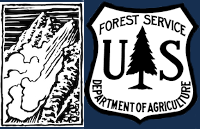Skier took a left turn under cornices to scrub speed and released a 6-10" windslab 40' wide which ran 10' at most. Super soft and easy to ski through. Photo: J Lee
24-25
Skier Triggered Wind Slab - Ice Cream Scoop
Ice Cream Scoop on Skiers Left Side in Gully, North Aspect, 9280'
SS-ASu-R1-D1-S
One of the few spots on the gully where there are no trees as a wind block on the skiers left (south) side. Noticed a few cornices on south side of gully where it is exposed to W/SW/S winds. Skier took a left turn under cornices to scrub speed and released a 6-10" windslab 40' wide which ran 10' at most. Super soft and easy to ski through.
The slope at the my skis broke about 15-20 meters wide and 15 cm deep at the flanks to 40cm deep in the gut, SS-ASu-R1-D1.5-I-M(L)-TK. About 30 meters downhill, the slab rode up onto the new snow and ran out of momentum before reaching the runout. Photo: J Negri
Beehive/Bear Obs
Skied around Beehive Basin today; there was lots of new snow and very little wind effect. Skied into the top of Bear Basin from Beehive by going up going home and down the east side, right-side-up powder skiing. While descending Island Boy into the South Fork of Spanish Creek, we had similar 60-100 cm of right-side-up new snow on a heavily textured melt-freeze layer of old snow. Felt the snow density stiffen up from light low density snow around 300 meters down the ski line so cut to the left into a safe zone, the slope at the my skis broke about 15-20 meters wide and 15 cm deep at the flanks to 40cm deep in the gut, SS-ASu-R1-D1.5-I-M(L)-TK. About 30 meters downhill, the slab rode up onto the new snow and ran out of momentum before reaching the runout. Right where the slope broke, we had wind wrapping around the north ridge cross-loading the couloir (skiers left to right), downslope, and on skiers' right of the line, there was no evidence of wind transport. Skied the rest of the line and looped back into Beehive with no other excitement.
Stabilizing Quickly
We rode Buck Ridge through First Yellowmule, Buck Creek, Second Yellowmule and into McAtee Basin. Pulses of snow through the day dropped an inch or two by the time we left. Light winds, no avalanches, and no signs of instability to report. The measured storm total above the melt-freeze crust was 11" (1.3" of SWE) at the top of 1st Yellowmule. The snow was well bonded to the underlying surface. Quick pits testing the snow above the melt-freeze crust yielded no indicators of instability.
The riding was quite nice other than the lowest section of the Doe Creek Road is melted out. It was fine on the way in, but very muddy on the way out.
Triggering an avalanche is unlikely UNLESS:
- The wind picks up to speeds capable of transporting snow.
- The temperatures increase or slopes get hit by the warm spring sun.
- There is another significant pulse of snowfall.
GNFAC Avalanche Forecast for Wed Apr 2, 2025
<p><span><span><span><strong><span><span>Avalanche Activity:</span></span></strong></span></span></span><span><span><span><span><span><span> Yesterday ski patrols easily triggered soft slab avalanches with ski cuts and explosives. In the Bridger Range where the most snow fell, those slides were much larger and ran surprising distances. Some of these slides broke at the new/old snow interface while others broke on soft layers within the new snow as Dave and Haylee found in the </span></span></span></span></span></span><a href="https://www.mtavalanche.com/node/34814"><span><span><span><span><span><… Bridgers yesterday</span></span></u></span></span></span></span></span></a><span><span><span><span><span><span>. A skier </span></span></span></span></span></span><a href="https://www.mtavalanche.com/node/34816"><span><span><span><span><span><… Cooke City intentionally triggered a soft slab</span></span></u></span></span></span></span></span></a><span><span><span><span><span><span> on a steep north facing slope.</span></span></span></span></span></span></p>
<p><span><span><span><span><span><span>There are three avalanche problems to consider today:</span></span></span></span></span></span></p>
<ol>
<li><span><span><span><strong><span><span>Wind slabs</span></span></strong></span></span></span><span><span><span><span><span><span> - The strongest winds happened yesterday morning. Fortunately winds overall have been pretty light. Along upper ridgelines and under cornices, light drifting has created pockets of thick new snow and soft wind slabs. These places will be the most likely spots to trigger an avalanche today, but they are also easy to avoid.</span></span></span></span></span></span></li>
<li><span><span><span><strong><span><span>Storm slabs</span></span></strong></span></span></span><span><span><span><span><span><span> - Since yesterday subtle layers in the new snow have been bonding to each other and to the old snow surface, thus reducing the odds of triggering a soft storm slab avalanche, but we can’t write this problem off just yet. </span></span></span></span></span></span></li>
<li><span><span><span><strong><span><span>Dry loose avalanches or sluffs</span></span></strong></span></span></span><span><span><span><span><span><span> - More snow falling today means there will be some sluffing in the steepest terrain. These types of avalanches typically start at your feet and are mostly a concern for skiers or snowboarders. Making a turn or two and stopping to let the sluff run ahead is one option. Read more </span></span></span></span></span></span><a href="https://avalanche.org/avalanche-encyclopedia/#dry-loose"><span><span><s…;
</ol>
<p><span><span><span><strong><span><span>Travel advice for today:</span></span></strong></span></span></span><span><span><span><span><span><span> </span></span></span></span></span></span><span><span><span><strong><span><span>(1)</span></span></strong></span></span></span><span><span><span><span><span><span> Avoid places at the tops or sides of slopes where winds have drifted some snow making the powder more cohesive and more likely to avalanche. </span></span></span></span></span></span><span><span><span><strong><span><span>(2)</span></span></strong></span></span></span><span><span><span><span><span><span> Watch for any signs like shooting cracks that the new snow is unstable and consider doing some quick tests like Dave shows </span></span></span></span></span></span><a href="https://youtu.be/FxgIax46oPc?feature=shared"><span><span><span><span><s… this video</span></span></u></span></span></span></span></span></a><span><span><span><span><span><span>. Jump on </span></span></span></span></span></span><a href="https://avalanche.org/avalanche-encyclopedia/#test-slope"><span><span><… test slopes</span></span></u></span></span></span></span></span></a><span><span><span><span><span><span> and walk/ride above other tracks to get a feel for how the new snow is bonded. </span></span></span></span></span></span><span><span><span><strong><span><span>(3)</span></span></strong></span></span></span><span><span><span><span><span><span> If getting into steeper terrain where getting pushed downhill could be a problem, consider </span></span></span></span></span></span><a href="https://avalanche.org/avalanche-encyclopedia/#dry-loose"><span><span><s… to manage sluffing</span></span></u></span></span></span></span></span></a><span><span><span><span><span><span>.</span></span></span></span></span></span></p>
<p><span><span><span><span><span><span>Today the avalanche danger is MODERATE.</span></span></span></span></span></span></p>
Storm/Wind Slab N aspect 9600', Cooke City
From email: "Ski touring near Cooke City today we intentionally triggered a storm slab/ wind slab on a steep north aspect around 9600'. It was about 6" deep, and 30' wide." Photo: B Fredlund
Forecast link: GNFAC Avalanche Forecast for Wed Apr 2, 2025
